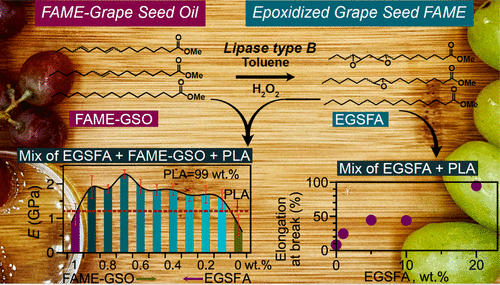当前位置:
X-MOL 学术
›
ACS Sustain. Chem. Eng.
›
论文详情
Our official English website, www.x-mol.net, welcomes your
feedback! (Note: you will need to create a separate account there.)
Chemoenzymatic Epoxidation of Highly Unsaturated Fatty Acid Methyl Ester and Its Application as Poly(lactic acid) Plasticizer
ACS Sustainable Chemistry & Engineering ( IF 7.1 ) Pub Date : 2021-12-09 , DOI: 10.1021/acssuschemeng.1c05934 Alejandro Sustaita-Rodríguez 1 , Alejandro Vega-Rios 2 , Alejandro Bugarin 3 , Víctor H. Ramos-Sánchez 1 , Alejandro A. Camacho-Dávila 1 , Beatriz Rocha-Gutiérrez 1 , David Chávez-Flores 1
ACS Sustainable Chemistry & Engineering ( IF 7.1 ) Pub Date : 2021-12-09 , DOI: 10.1021/acssuschemeng.1c05934 Alejandro Sustaita-Rodríguez 1 , Alejandro Vega-Rios 2 , Alejandro Bugarin 3 , Víctor H. Ramos-Sánchez 1 , Alejandro A. Camacho-Dávila 1 , Beatriz Rocha-Gutiérrez 1 , David Chávez-Flores 1
Affiliation

|
It is well known that petroleum-derived plasticizers are causing continuous environmental and health issues. Recently, fatty acid methyl esters (FAMEs), also known as biodiesels, have emerged as sustainable alternatives to produce epoxides that can be used as greener plasticizers. In this regard, enzymatic catalysis has emerged as an ideal alternative for the epoxidation of biodiesels due to the observed high yields and adducts purity. The present study employed Candida antarctica lipase as a biocatalyst to epoxidize FAME from grape seed oil (GSO). Freshly prepared epoxides of grape seed FAME (EGSFA) were studied as plasticizers mixed with poly(lactic acid) (PLA). Subsequently, chemical transesterification of GSO, with potassium methoxide, was achieved in 96% yield, whereas the catalytic enzymatic epoxidation afforded the expected EGSFA in 97% yield. According to dynamic mechanical analysis (DMA), the new blends exhibited a significant elongation versus PLA alone. In addition, Young’s modulus of PLA decreased from 1.23 to 1.10 GPa, indicating a better stiffness. The present study also explored the relationship between EGSFA and FAME–GSO and its effect on the mechanical and thermal properties of PLA. Finally, the mechanical and thermal properties of PLA/EGSFA/FAME–GSO blends were analyzed by thermal gravimetrical analysis (TGA) and differential scanning calorimetry (DSC). The data acquired clearly show that formulations based on EGSFA content, specifically at 0.70 wt %, have superior properties than neat PLA. For example, Youngs’ modulus was 2.2 and 1.2 GPa for the blend and PLA, respectively. On the basis of the results, EGSFA and FAME–GSO have primary and secondary plasticizer attributes, respectively.
中文翻译:

高不饱和脂肪酸甲酯的化学酶促环氧化及其作为聚乳酸增塑剂的应用
众所周知,石油衍生的增塑剂正在引起持续的环境和健康问题。最近,脂肪酸甲酯 (FAME),也称为生物柴油,已成为生产可用作更环保增塑剂的环氧化物的可持续替代品。在这方面,由于观察到的高产率和加合物纯度,酶催化已成为生物柴油环氧化的理想替代方案。本研究采用南极念珠菌脂肪酶作为生物催化剂来环氧化葡萄籽油 (GSO) 中的 FAME。研究了新鲜制备的葡萄籽 FAME (EGSFA) 环氧化物作为与聚乳酸 (PLA) 混合的增塑剂。随后,GSO 与甲醇钾的化学酯交换以 96% 的产率实现,而催化酶促环氧化以 97% 的产率提供预期的 EGSFA。根据动态力学分析 (DMA),新共混物与单独的 PLA 相比表现出显着的伸长率。此外,PLA 的杨氏模量从 1.23 GPa 降低到 1.10 GPa,表明具有更好的刚度。本研究还探讨了 EGSFA 和 FAME-GSO 之间的关系及其对 PLA 机械和热性能的影响。最后,通过热重分析 (TGA) 和差示扫描量热法 (DSC) 分析了 PLA/EGSFA/FAME-GSO 共混物的机械和热性能。获得的数据清楚地表明,基于 EGSFA 含量的配方,特别是 0.70 重量%,比纯 PLA 具有更好的性能。例如,共混物和 PLA 的杨氏模量分别为 2.2 和 1.2 GPa。根据结果,EGSFA 和 FAME-GSO 分别具有主要和次要增塑剂属性。
更新日期:2021-12-20
中文翻译:

高不饱和脂肪酸甲酯的化学酶促环氧化及其作为聚乳酸增塑剂的应用
众所周知,石油衍生的增塑剂正在引起持续的环境和健康问题。最近,脂肪酸甲酯 (FAME),也称为生物柴油,已成为生产可用作更环保增塑剂的环氧化物的可持续替代品。在这方面,由于观察到的高产率和加合物纯度,酶催化已成为生物柴油环氧化的理想替代方案。本研究采用南极念珠菌脂肪酶作为生物催化剂来环氧化葡萄籽油 (GSO) 中的 FAME。研究了新鲜制备的葡萄籽 FAME (EGSFA) 环氧化物作为与聚乳酸 (PLA) 混合的增塑剂。随后,GSO 与甲醇钾的化学酯交换以 96% 的产率实现,而催化酶促环氧化以 97% 的产率提供预期的 EGSFA。根据动态力学分析 (DMA),新共混物与单独的 PLA 相比表现出显着的伸长率。此外,PLA 的杨氏模量从 1.23 GPa 降低到 1.10 GPa,表明具有更好的刚度。本研究还探讨了 EGSFA 和 FAME-GSO 之间的关系及其对 PLA 机械和热性能的影响。最后,通过热重分析 (TGA) 和差示扫描量热法 (DSC) 分析了 PLA/EGSFA/FAME-GSO 共混物的机械和热性能。获得的数据清楚地表明,基于 EGSFA 含量的配方,特别是 0.70 重量%,比纯 PLA 具有更好的性能。例如,共混物和 PLA 的杨氏模量分别为 2.2 和 1.2 GPa。根据结果,EGSFA 和 FAME-GSO 分别具有主要和次要增塑剂属性。


















































 京公网安备 11010802027423号
京公网安备 11010802027423号